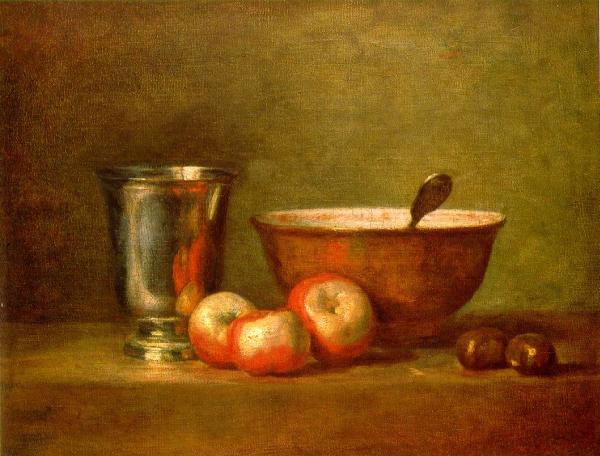Jean-Baptiste-Simeon Chardin Gallery
Oil on canvas (190 Kb), 33 x 41 cm (13 x 16 1/4"); Musée du Louvre, Paris
French painter, one of the greatest of the 18th century, whose genre and still life subjects documented the life of the Paris bourgeoisie. He favored simple still lifes and unsentimental domestic interiors. His muted tones and ability to evoke textures are seen in Benediction and Return from Market (Louvre) and Blowing Bubbles and Mme Chardin (Metropolitan Museum). His unusual abstract compositions had great influence.
Chardin was born in Paris, November 2, 1699, the son of a cabinetmaker. Largely self-taught, he was strongly influenced by 17th-century Low Country masters such as Metsu and de Hooch. Like them, he devoted himself to simple subjects and common themes. His lifelong work in this style contrasted sharply with the heroic historical subjects and lighthearted rococo scenes that constituted the mainstream of art during the mid-18th century.
Chardin was admitted to the Royal Academy of Painting and Sculpture in 1728 on the basis of two early still lifes, The Skate and The Buffet (both 1728, Louvre, Paris). In the 1730s, he began to paint scenes of everyday life in bourgeois Paris, among them Lady Sealing a Letter (1733, former State Museums, Berlin), Scouring Maid (1738, Hunterian Museum, Glasgow, Scotland), and The Benediction (1740, Louvre). Characterized by subdued colors and mellow lighting, these works celebrate the beauty of their commonplace subjects and project an aura of humanity, intimacy, and honest domesticity. Chardin's technical skill gave his paintings an uncannily realistic texture. He rendered forms by means of light by using thick, layered brushstrokes and thin, luminous glazes. Called the grand magician by critics, he achieved a mastery in these areas unequaled by any other 18th-century painter. Chardin's early support came from aristocratic patrons, including King Louis XV. He later gained a wider popularity when engraved copies of his works were produced. He turned to pastels in later life when his eyesight began to fail. Unappreciated at the time, these pastels are now highly valued. Chardin died in Paris, December 6, 1779.

viewer |
|
|
Silver Goblet |
| Soap Bubble |
| Girl Peeling Vegetables |
| Canary |
| Water Glass and Jug |
| Pheasant and Hunting Bag |
| Laundress |
Biography
Bulletin Board
Renowned Art
(home)
Jean-Baptiste-Siméon Chardin was born, lived and died in Paris. He is known for his beautifully textured still lifes as well as his sensitive and touching genre paintings. Simple, even stark, but treasured paintings of common household items and an uncanny ability to portray children's innocence in a nonsentimental manner make his paintings universal across time.
all artists, with thumbnails: by birth year | alphabetically
all artists: by birth year | alphabetically
artists born in the 13th 14th 15th 16th 17th 18th 19th 20th century